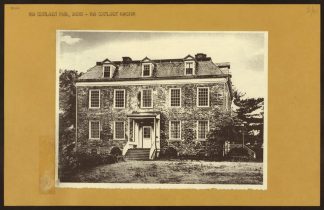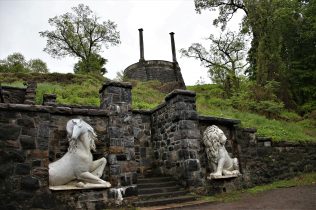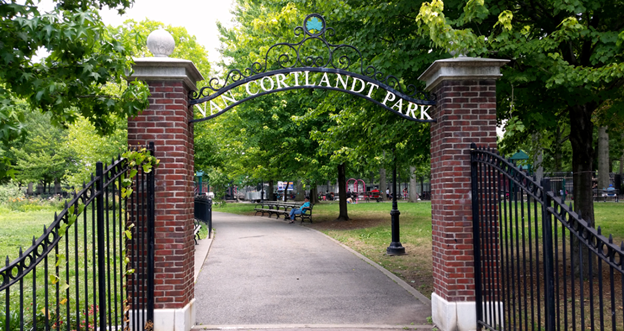Found within the Bronx borough of New York City, Van Cortlandt Park is a refuge for inhabitants of the city trying to escape its fast-paced environment. Being founded in the Dutch colonial period, this 1,146-acre estate finds itself as the third largest park in New York City. Along with its vast history, Van Cortlandt Park is home to countless outdoor activities such as five unique hiking trails, several freshwater fishing lakes, and two public golf courses.
In the times before European Settlement, the lands of modern-day New York City and Van Cortlandt Park were native to the Weckquaesgeek Lenape first peoples. On these lands the Lenape found easy access to the Hudson River, forests for hunting, and fertile lands for crop growth. As the new world was being uncovered by Europeans, businessmen of the Dutch West India Company bought the lands of Manhattan Island. Among these businessmen and first settlers in Dutch New Amsterdam, was Oloff Stevense Van Cortlandt who quickly became one of the most influential and richest men in the colony through his slave shipping and brewery endeavors. Jacobus Van Cortlandt, the youngest of Oloff’s children purchased the lands of modern-Day Van Cortlandt Park. Jacobus much like his father was a very influential man within the New York City colony serving as the colony’s mayor 30th and 33rd mayor[1]. On these lands, Jacobus benefitted off the enslavement of both Native Americans and Africans on his large wheat plantation. These enslaved individuals along with his son Frederick Van Cortlandt worked the many aspects of Van Cortlandt’s businesses within the Van Cortlandt Estate as Jacobus’s primary residences and work-related matters were found in the main colony of New York City[2].
Van Cortlandt house was completed in 1748, to this day it is the oldest surviving building in the Bronx. Located at the Southwestern part of the estate, the Van Cortlandt house is two and a half story tall building comprised of both fieldstone and wood. The style of architecture of the Van Cortlandt house was Gregorian meaning it was proportional in size and had symmetrical details on all sides. The Van Cortlandt’s owned many slaves which performed the tasks of keeping up the Van Cortlandt home. Some of the jobs that the enslaved individuals did around the house was to bring fresh water to and from the house as modern plumbing had not yet been invented until the beginning of the Croton Water Works in 1837. Other jobs these slaves had was to collect firewood, make food, and take care of the elderly Van Cortlandts. In 1821, Frederick’s son Augustus Van Cortlandt manumitted his slave Dinah, for “The great care and attention she paid my deceased affectionate wife during her last illness.[3]” The Van Cortlandt house and estate also played a key role during the Revolutionary War.

During the Revolutionary War, England focused much of its forces on the capturing of key ports across the newly founded America. One of which was New York City, which quickly fell to British rule after George Washington’s defeat at Kips Bay. This put many cities folk to choose their fates whether or not to stay loyal to the British Empire or to fight for independence as patriots. Frederick Van Cortland’s son James, who was in charge of the Van Cortlandt Estate, had the tough decision of choosing whether to continue living under the rule of Britain which treated him well as he was an influential powerful man in the colony, or fight for the independence of the United States. In 1775, James Van Cortlandt served within the Westchester County militia and aided the patriot army within the Revolutionary war[4]. His cousin Philip Van Cortlandt commanded the Second New York regiment in the Continental Army[5]. With this clear allyship to the United States coming from the Van Cortlandt family, George Washington used the Van Cortlandt house as a temporary place of residence as he spent many years bouncing between settlements of the United States. In 1778, on the property of the Van Cortlandt’s, the battle of Indian Field took place. The Stockton Mohicans, a tribe of Indians in the upper Hudson valley, fought in the American Revolutionary war. These young men led by their Chief Abraham Ninham refused to surrender despite being outnumbered, 17 young Mohican men died for the Independence of the United States. The Battle of Indian Field was the only battle to occur on the confines of the Van Cortlandt property [6].
After the revolutionary war continuing on into the 19th century, infrastructure changes occurred all throughout New York City, specifically with the creation of the Old Croton Aqueduct. The Old Croton Aqueduct brought freshwater from the Croton River to the main reservoir in Manhattan, located at the modern-day main branch of the New York Public Library. The aqueduct stretches for 41 miles all the way through the Bronx towards Manhattan, it is no coincidence that a large portion of the aqueduct can find itself running through the lands of the Van Cortlandt’s. With the exponential growth of New York City’s population, and the recent cholera epidemic, more individuals of the city needed access to fresh drinking water. However, water from the Croton Aqueduct for a long time was a luxury, as only the wealthiest of New York City’s inhabitants had connections to it. Since the 19th century, many of the Old Croton Aqueduct has been demolished for new buildings as there have been new and improved methods of water treatment and distribution within New York City. However, many remnants find themselves on Van Cortlandt park’s aqueduct trail. The Van Cortlandt Aqueduct trail is only 1.1 miles long but incorporates both the natural scenery and historical weirs, buildings, and underground tunnels associated with the Old Croton Aqueduct.


In 1888 Augustus Van Cortlandt sold the Van Cortlandt Estate and house to the City of New York. Today, it is under control of the New York City parks and recreation department. Overtime, the once home of the many Van Cortlandt’s has been changed into a museum, and the many plantations that aided in the Van Cortlandt’s wealth have been altered into many things such as the first public golf course in not only New York City but the entire United States. Other fields that such as Indian Field where the battle of the Revolutionary War took place, have been commemorated with a statue of Abraham Ninham. One of the main people who renovated Van Cortlandt Park to what it is today was the head of the New York City Parks Department in 1933, Robert Moses. Moses fixed the outdated infrastructure of the park through the addition of park lights, paving dirt roads, and building walkways throughout the park[7]. Moses during his tenure as Parks commissioner also added baseball fields, soccer fields, and swimming pools to attract visitors to the historic park. Other attractions to Van Cortlandt Park are the five hiking trails: Cass Gallagher Nature Trail, John Kieran Trail, John Muir Trail, Old Croton Aqueduct Trail, Putnam Trail. These trails combined extend for more than 20 miles allowing for different sceneries of nature which can be forgotten in a metropolis such as New York City. Van Cortlandt Park also has entertainment opportunities for college students. Van Cortlandt Park is the training grounds for countless of the city’s colleges cross country teams such as Manhattan College, Columbia University, and Iona College.
Van Cortlandt Park is the inverse of what New York City is today. Throughout time from New Amsterdam to New York, the surroundings of the city have changed and rebuilt itself time and time again. As the population of the city grew, and the city expanded into the five boroughs it is today there is hardly a place where one can see what the lands of New York City was previous to becoming the metropolis it is today. However, in the confines of the Van Cortlandt Estate, many things remained much the same. From the same years the first Van Cortlandt’s such as Jacobus stepped foot on their estate the same structures and they once lived in are still intact today. Structures such as the Old Croton Aqueduct which were demolished all throughout the city can be found standing in parts of Van Cortlandt Park today. Finally, the natural world which can be almost nonexistent walking around the concrete jungle can be found in Van Cortlandt Park.
In text citations:
[1] Stephanus van Cortlandt, accessed March 30, 2022, https://www.newnetherlandinstitute.org/history-and-heritage/dutch_americans/stephanus-van-cortlandt/.
[2] Bankoff, H. Arthur, and Frederick A. Winter. “The Archaeology of Slavery at the Van Cortlandt Plantation in the Bronx, New York.” International Journal of Historical Archaeology 9, no. 4 (2005): 291–318. http://www.jstor.org/stable/20853087.
[3] “Van Cortlandt House,” Van Cortlandt Park Alliance, accessed April 1, 2022, https://vancortlandt.org/tour_enslavedafrican/van-cortlandt-house/.
[4] “The History of Van Cortlandt House and Museum,” Van Cortlandt House Museum, accessed April 2, 2022, http://www.vchm.org/the-history-of-van-cortlandt-house-and-family.html.
[5] Stephanus van Cortlandt, accessed April 2, 2022, https://www.newnetherlandinstitute.org/history-and-heritage/dutch_americans/stephanus-van-cortlandt/.
[6] “Van Cortlandt Park,” Van Cortlandt Park Highlights – Indian Field : NYC Parks, accessed April 2, 2022, https://www.nycgovparks.org/parks/VanCortlandtPark/highlights/11610.
[7] New York City Parks Department & Storch Associates 1986b, p. 96.
Works Cited:
Bankoff, H. Arthur, and Frederick A. Winter. “The Archaeology of Slavery at the Van Cortlandt Plantation in the Bronx, New York.” International Journal of Historical Archaeology 9, no. 4 (2005): 291–318. http://www.jstor.org/stable/20853087.
Bromley , George Washington. 35 Ward 24. n.d. Dave Rumsey Map Collection. https://www.davidrumsey.com/luna/servlet/detail/RUMSEY~8~1~30309~1140827:35-ward-24-?sort=pub_list_no_initialsort%2Cpub_date%2Cpub_list_no%2Cseries_no&qvq=q:van%20cortlandt%20park;sort:pub_list_no_initialsort%2Cpub_date%2Cpub_list_no%2Cseries_no;lc:RUMSEY~8~1&mi=1&trs=4#.
García Conde, Ed. Van Cortland Park Gate. Van Cortlandt Park: The Bronx’s Answer To Central Park. Welcome2TheBronx, July 9, 2014. https://www.welcome2thebronx.com/2014/07/09/van-cortlandt-park-the-bronxs-answer-to-central-park/.
Michael, Keith. Old Croton Aqueduct Trail. May 12, 2019. Https://Www.flickr.com. https://www.flickr.com/photos/keithmichaelnyc/47885533541.
Stephanus van Cortlandt. Accessed March 30, 2022. https://www.newnetherlandinstitute.org/history-and-heritage/dutch_americans/stephanus-van-cortlandt/.
“Van Cortlandt House,” Van Cortlandt Park Alliance, accessed April 1, 2022, https://vancortlandt.org/tour_enslavedafrican/van-cortlandt-house/.
“Van Cortlandt Park, Borough of the Bronx: Restoration Master Plan,” (PDF). New York City Parks Department, Storch Associates. 1986. Retrieved April 23, 2022.
